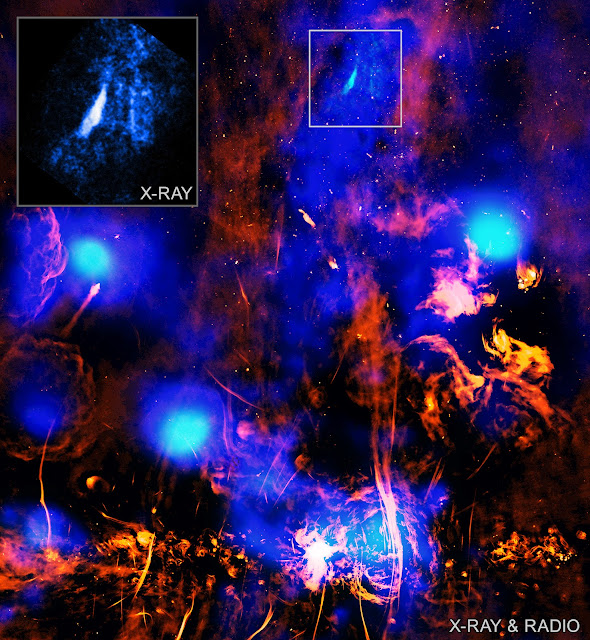Milky Way Black Hole Venting Activity Detected | NASA Chandra X-ray Observatory

This image shows a region near the center of our Milky Way galaxy in X-ray and radio light. At the bottom of the image, near the center, is a brilliant, tangled knot of material that resembles a paint splatter. This is the brightest region in the image, and it contains the supermassive black hole at center of our galaxy, known as Sagittarius A*.
The lower third of the image resembles an angry firestorm. Streaks of red and orange are scattered in every direction, as if a legion of embers from a fire crackled and popped into the air all at once. Flame-like structures lick toward the center from our right.
Much of the image is infused with wispy blue clouds showing X-rays detected by Chandra. At a few points, the wispy blue clouds seem to form into balls of teal colored light and are known as dust halos. They are caused by X-rays from bright X-ray sources reflecting off dust surrounding the sources. These dust halos resemble underwater lights glowing in a cloudy swimming pool at night.

A labeled version of the image gives the locations of the exhaust vent, the chimney, the supermassive black hole at the center of the Milky Way Galaxy (called Sagittarius A*, or Sgr A* for short) and the plane of the galaxy. Rising up from Sagittarius A* in the center of the image is a pillar of blue light referred to as a chimney. This chimney of hot gas is surrounded by red clouds that are filled with stars, presenting themselves as tiny red flecks. To emphasize the chimney and exhaust vent features the image has been rotated by 180 degrees from the conventional orientation used by astronomers, so that the chimney is pointed upwards.
These images show evidence for an exhaust vent attached to a chimney releasing hot gas from a region around the supermassive black hole at the center of the Milky Way. In the main image of this graphic, X-rays from NASA’s Chandra X-ray Observatory (blue) have been combined with radio data from the MeerKAT telescope (red).
Previously, astronomers had identified a “chimney” of hot gas near the Galactic Center using X-ray data from Chandra and ESA’s XMM-Newton. Radio emission detected by MeerKAT shows the effect of magnetic fields enclosing the gas in the chimney.
Several X-ray ridges showing brighter X-rays appear in white, roughly perpendicular to the plane of the Galaxy. Researchers think these are the walls of a tunnel, shaped like a cylinder. This helps funnel hot gas as it moves upwards along the chimney and away from the Galactic Center.
Chandra data reveal several X-ray ridges that astronomers think are the walls of a tunnel, shaped like a cylinder. It helps to funnel hot gas as it moves away from the Galactic Center. This “exhaust vent” is connected to a previously-discovered “chimney” and helps release hot gas generated by the supermassive black hole at the Galactic Center. Chandra’s X-rays are shown with radio data from MeerKAT to demonstrate the chimney and vent, with a closer-in view of the exhaust vent as well. Our galaxy's supermassive black hole is near the bottom of the images.
The newly discovered vent is located near the top of the chimney about 700 light-years from the center of the Galaxy.
The authors of the new study think that the exhaust vent formed when hot gas rising through the chimney struck cooler gas lying in its path. The brightness of the exhaust vent walls in X-rays is caused by shock waves—similar to sonic booms from supersonic planes—generated by this collision. The left side of the exhaust vent is likely particularly bright in X-rays because the gas flowing upwards is striking the tunnel wall at a more direct angle and with more force than other regions.
The researchers determined that the hot gas is most likely coming from a sequence of events involving material falling towards Sgr A*. They think eruptions from the black hole then drove the gas upwards along the chimneys, and out through the exhaust vent.
It is unclear how often material is falling onto Sgr A*. Previous studies have indicated that dramatic X-ray flares take place every few hundred years at or near the location of the central black hole, so those could play important roles in driving the hot gas upwards through the exhaust vent. Astronomers also estimate that the Galactic black hole rips apart and swallows a star every 20,000 years or so. Such events would lead to powerful, explosive releases of energy, much of which would be destined to rise through the chimney vent.
The paper describing these results is published in The Astrophysical Journal and a preprint is available online. The authors of the paper are Scott Mackey (University of Chicago), Mark Morris (University of California, Los Angeles), Gabriele Ponti (Italian National Institute of Astrophysics in Merate ), Konstantina Anastasopoulou (Italian National Institute of Astrophysics in Palermo), and Samaresh Mondal (Italian National Institute of Astrophysics in Merate).
NASA’s Marshall Space Flight Center manages the Chandra program. The Smithsonian Astrophysical Observatory’s Chandra X-ray Center (CXC) controls science operations from Cambridge, Massachusetts, and flight operations from Burlington, Massachusetts.
Image Credit: NASA's Marshall Space Flight Center (MSFC)/X-ray: NASA/CXC/Univ. of Chicago/S.C. Mackey et al.; Radio: NRF/SARAO/MeerKAT
Image Processing: NASA/CXC/SAO/N. Wolk
Release Date: May 9, 2024
#NASA #Space #Astronomy #Science #BlackHole #Venting #Chimney #SajAstar #SagittariusAstar #MilkyWayGalaxy #Cosmos #Universe #Astrophysics #NASAChandra #ChandraObservatory #Xray #SpaceTelescope #MSFC #SAO #CXC #UnitedStates #MeerKAT #RadioTelescope #SouthAfrica #Infographic #STEM #Education




.jpg)











